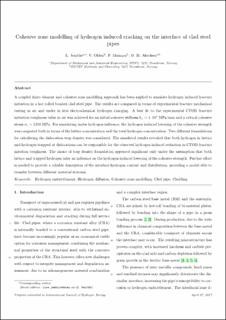| dc.contributor.author | Jemblie, Lise | |
| dc.contributor.author | Olden, Vigdis | |
| dc.contributor.author | Maincon, Philippe Emmanuel | |
| dc.contributor.author | Akselsen, Odd Magne | |
| dc.date.accessioned | 2020-12-23T09:20:21Z | |
| dc.date.available | 2020-12-23T09:20:21Z | |
| dc.date.created | 2017-11-26T15:45:46Z | |
| dc.date.issued | 2017 | |
| dc.identifier.citation | International journal of hydrogen energy. 2017, 42 (47), 28622-28634. | en_US |
| dc.identifier.issn | 0360-3199 | |
| dc.identifier.uri | https://hdl.handle.net/11250/2720886 | |
| dc.description.abstract | A coupled finite element hydrogen diffusion and cohesive zone modelling approach has been applied to simulate hydrogen induced fracture initiation in a hot rolled bonded clad steel pipe. The results are compared to experimental fracture mechanical testing in air and under in situ electrochemical hydrogen charging. A best fit to the experimental fracture initiation toughness value in air was achieved for an initial cohesive stiffness kn = 4·106 MPa/mm and a critical cohesive stress σc = 1210 MPa. For simulating under hydrogen influence, the hydrogen induced lowering of the cohesive energy was computed both in terms of the lattice concentration and the total concentration. Two different formulations for calculating the dislocation trap density were considered. The simulated results revealed that both hydrogen in lattice and hydrogen trapped at dislocations can be responsible for the observed hydrogen induced reduction in fracture initiation toughness. The choice of trap density formulation appeared significant only under the assumption that both lattice and trapped hydrogen infer an influence on the hydrogen induced lowering of the cohesive strength. Further effort is needed to provide a reliable description of the interface hydrogen content and distribution. | en_US |
| dc.language.iso | eng | en_US |
| dc.publisher | Elsevier | en_US |
| dc.rights | Attribution-NonCommercial-NoDerivatives 4.0 Internasjonal | * |
| dc.rights.uri | http://creativecommons.org/licenses/by-nc-nd/4.0/deed.no | * |
| dc.subject | Cladding | en_US |
| dc.subject | Clad pipe | en_US |
| dc.subject | Cohesive zone modelling | en_US |
| dc.subject | Hydrogen diffusion | en_US |
| dc.subject | Hydrogen embrittlement | en_US |
| dc.title | Cohesive zone modelling of hydrogen induced cracking on the interface of clad steel pipes | en_US |
| dc.type | Peer reviewed | en_US |
| dc.type | Journal article | en_US |
| dc.description.version | acceptedVersion | en_US |
| dc.rights.holder | © 2017. This is the authors’ accepted and refereed manuscript to the article. This manuscript version is made available under the CC-BY-NC-ND 4.0 license http://creativecommons.org/licenses/by-nc-nd/4.0/ | en_US |
| dc.source.pagenumber | 28622-28634 | en_US |
| dc.source.volume | 42 | en_US |
| dc.source.journal | International journal of hydrogen energy | en_US |
| dc.source.issue | 47 | en_US |
| dc.identifier.doi | 10.1016/j.ijhydene.2017.09.051 | |
| dc.identifier.cristin | 1518512 | |
| dc.relation.project | Norges forskningsråd: 234110 | en_US |
| cristin.unitcode | 7401,80,64,0 | |
| cristin.unitname | Materialer og nanoteknologi | |
| cristin.ispublished | true | |
| cristin.fulltext | preprint | |
| cristin.qualitycode | 2 | |

